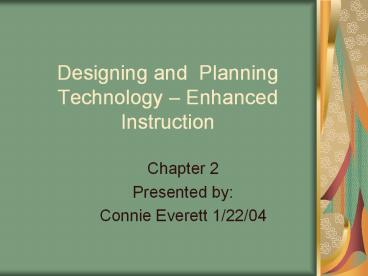Designing and Planning Technology – Enhanced Instruction PowerPoint PPT Presentation
1 / 24
Title: Designing and Planning Technology – Enhanced Instruction
1
Designing and Planning Technology Enhanced
Instruction
- Chapter 2
- Presented by
- Connie Everett 1/22/04
2
What Is a Learning Environment?
- A learning environment as applied to education
includes all the conditions, circumstances, and
influences that affect the learners development.
3
The Learning Environment Affects Teaching and
Learning.
- Dunn and Dunn (1992) completed a extensive
research on matching the physical environment to
individual learning styles. - The learning environment includes the space and
facilities in which instruction occurs. - To adjust the physical learning space to maximize
its compatibility with learners, it is important
to first carefully identify the learning styles
of the learners.
4
The Learning Environment continued
- The learning environment includes both tangible
and intangible elements. - It will be necessary to take the time to create a
systematic plan that will ensure that each step
you take, whether adjusting the physical
environment or altering an instructional
component, adds to the effectiveness of the
learning environment.
5
Using an Instructional Planning System
- Effective instruction is instruction that has
been thoroughly thought out and articulated by a
skillful and creative educator. - The notion of a carefully planned step by step
process to design, create, evaluate and revise
instruction is called a systems approach to
instruction.
6
The Design-Plan-Act (D-P-A ) SYSTEM
- Designing the instruction.
- Articulating specific lesson plans
- Developing an instructional action plan.
7
The Design Phase
- Design identifies over-all goals and the steps to
achieve them. - An instructional design model is used to help
educators in the first phase of the planning
system to envision their planned instruction
holistically. - Using such a model as a foundation, you will
ultimately be able to develop an effective lesson
plan and a subsequent instructional action plan.
8
DID model steps
- Know the Learners
- State your Objectives
- Establish the learning environment
- Identify teaching learning strategies
- Identify and select technologies
- Summative evaluation
- Table 2.1 DID Formative and Summative Feedback
Loops (pg 40)
9
The Dynamic Instructional Design Model (DID)
- The DID model is a flexible system for designing
instruction. - The DID model includes all of the critical
elements in the design of effective instruction. - The DID model sets up the curricular framework.
- Formative feedback occurs while the learning
event is in progress - Summative feedback is feedback that occurs at the
conclusion of the learning event.
10
Using the DID Model to Plan Instruction
- The model helps you ask yourself the crucial
question that will improve the quality of the
instructional experience for both you and your
students. - Table 2.9 (pg 57) provides a template with a
series of prompts to help you build your own
design.
11
Using the DID Model to Create Lesson Plans
- The systematic planning of instruction remains
the foundation of effective teaching and learning.
12
Lesson Planning
- The lesson plan provides daily guide for
teachers. - It is the lesson plan that provides a day-to-day
snapshot of what will happen in the classroom.
13
Lesson Planning continued
- Ready the Learner - Describe how you will prepare
the students for the lesson. - Target Specific Objectives State the
instructional design objective that will be
addressed by this lesson. - Prepare the Lesson Describe what you need to do
to prepare for the lesson. - Table 2.10- The lesson planner with examples.
14
The Lesson Planner Practical Application of the
DID Model
- The lesson planner is the pragmatic product of
the instructional design process.
15
Instructional Action PlanningThe Instructional
Action Plan (IAP)
- Identifying learner preparation activities
- Getting the classroom ready
- Teaching-learning activities
- Personal prompts
- Support technologies
- Getting and using feedback
- Follow-up activities
- Table 2.11 (pg 64)
16
The Instructional Action Planner
- Getting Ready to Teach
- Linking Planning, Learning, and Teaching
- Design
- Plan
- Act
- Design-Plan-Act! Completes the instructional
systems cycle.
17
Design
- Instructional design is the component of the
process that helps you think strategically about
the teaching and learning experience you are
targeting.
18
Act
- Action planning is the final step in the
three-part planning process - Design-Plan-Act! Completes the instructional
systems cycle.
19
Plan
- The lesson plan brings the instructional design
down to earth.
20
Linking Planning, Learning, and Teaching.
- Just as you would carefully plan and rehearse an
important speech before giving it, so too must
you carefully plan and rehearse the important
communication process that takes place between
teacher and learner.
21
Planning for Technology in Teaching and Learning
- All aspects of instruction benefit from careful
planning, but for using technology in
instruction, planning is especially critical. - A well designed learning event ensures that the
appropriate technology is used. - Teachers must plan for, select, and effectively
use the best technologies to support teaching and
learning.
22
Key Terms page 67
- Blooms taxonomy
- Design-plan-act system (D-P-A)
- DID model
- Feedback loops
- Formative feedback
- Instructional action plan (IAP)
- Instructional design model
- Learning environment
- Learning strategies
- Lesson planner
- Media
- Methods
- Motivators
- Pedagogy
- Performance objectives
- Preorganizer
- Scaffolding
- Summative feedback
- Systems approach
- Teaching strategies
23
Key Theorists
- Benjamin Bloom
- Rita and Kenneth Dunn
- Robert Gagne
24
The End

